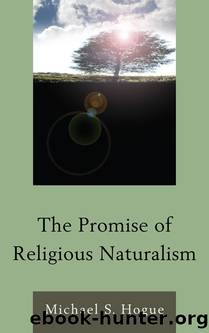The Promise of Religious Naturalism by Hogue Michael S.;

Author:Hogue, Michael S.; [Hogue]
Language: eng
Format: epub
Publisher: Rowman & Littlefield Unlimited Model
Published: 2010-08-15T00:00:00+00:00
Chapter Four
v
What Is Ethical
about Religious Naturalism?
The purpose of this chapter is to interpret and compare how Loyal Rue, Jerome Stone, Ursula Goodenough, and Donald Crosby understand what is ethical about their versions of religious naturalism. This chapterâs shift to the ethical is a critical one with respect to the larger aim of this book to appreciatively critique these thinkersâ versions of religious naturalism in relation to the global moral challenges of the ecological crisis as well as to the context of post-traditional religious pluralism. Before moving more directly into this work, it will be helpful to situate it in relation to the summary comparative conclusions offered in the last chapter.
The previous chapter focused on the question of how Rue, Stone, Goodenough, and Crosby naturalistically interpret the functions of religion and the phenomenology of religiosity. I argued that each of the thinkers offers some version of an integrated functionalist-phenomenological philosophy of religion, though it was made apparent that each of these integrations presents distinct contributions and challenges. I also showed how each of these religious naturalists presents a slightly different take on the question of the relation of religious naturalism to other religious traditions. While Rue and Crosby present more apologetic cases, in the sense that they both articulate religious naturalism as a superior alternative to other forms of religious life, Stone and Goodenough attempt to present religious naturalism in ways that are either explicitly informed by or complementary to other religious traditions.
I also discussed how these different approaches to other traditions were shaped by various universalist intentions. While Rueâs apologetics is primarily influenced by a biologically grounded evolutionary functionalist conception of religion, a functionalism that therefore includes a biologically oriented universalist intention, Crosbyâs apologetics is primarily influenced by a philosophical account of the phenomenological functions of religious objects. The universalist intention in Crosbyâs work, a bit differently from Rueâs, is thus rooted in an account of the personal and cosmological significance of religious objects rather than the functional morphology of religion as such. In contrast to both Crosby and Rue, the universalist intentions of Stone and Goodenough were shown to be a bit more modest. Similarly to Crosby, and in contrast to Rue, Stoneâs philosophy of religion is phenomenologically oriented. But somewhat differently from Crosby, Stoneâs phenomenology of religious experience is organized by questions about scope, orientation, and dispositions of religiosity, rather than questions about the personal and cosmic functions of religious objects. While Goodenoughâs philosophy of religion is deeply informed by Rueâs, she leans more phenomenologically than Rue. But differently from Stone and Crosby, Goodenoughâs phenomenology is more explicitly rooted in the affective dimensions of religiosity. Thus, Rueâs universal intent is informed by an evolutionary functionalism; Stoneâs by a phenomenology of the scope, orientation, and dispositions of religious experience; Goodenoughâs by a deeply organic phenomenology of the affective dimensions of religiosity; and Crosbyâs by an explicitly functionalist-phenomenology of religious objects.
In addition to bringing these comparative differences to light, I also briefly touched on questions regarding these thinkersâ activist intentions.
Download
This site does not store any files on its server. We only index and link to content provided by other sites. Please contact the content providers to delete copyright contents if any and email us, we'll remove relevant links or contents immediately.
The Lost Art of Listening by Michael P. Nichols(7403)
Why I Am Not A Calvinist by Dr. Peter S. Ruckman(4099)
The Rosicrucians by Christopher McIntosh(3465)
Wicca: a guide for the solitary practitioner by Scott Cunningham(3125)
Signature in the Cell: DNA and the Evidence for Intelligent Design by Stephen C. Meyer(3071)
Real Sex by Lauren F. Winner(2966)
The Holy Spirit by Billy Graham(2892)
To Light a Sacred Flame by Silver RavenWolf(2767)
The End of Faith by Sam Harris(2687)
The Gnostic Gospels by Pagels Elaine(2468)
Waking Up by Sam Harris(2389)
Nine Parts of Desire by Geraldine Brooks(2325)
Jesus by Paul Johnson(2309)
Devil, The by Almond Philip C(2279)
The God delusion by Richard Dawkins(2264)
Heavens on Earth by Michael Shermer(2234)
Kundalini by Gopi Krishna(2136)
Chosen by God by R. C. Sproul(2122)
The Nature of Consciousness by Rupert Spira(2044)
